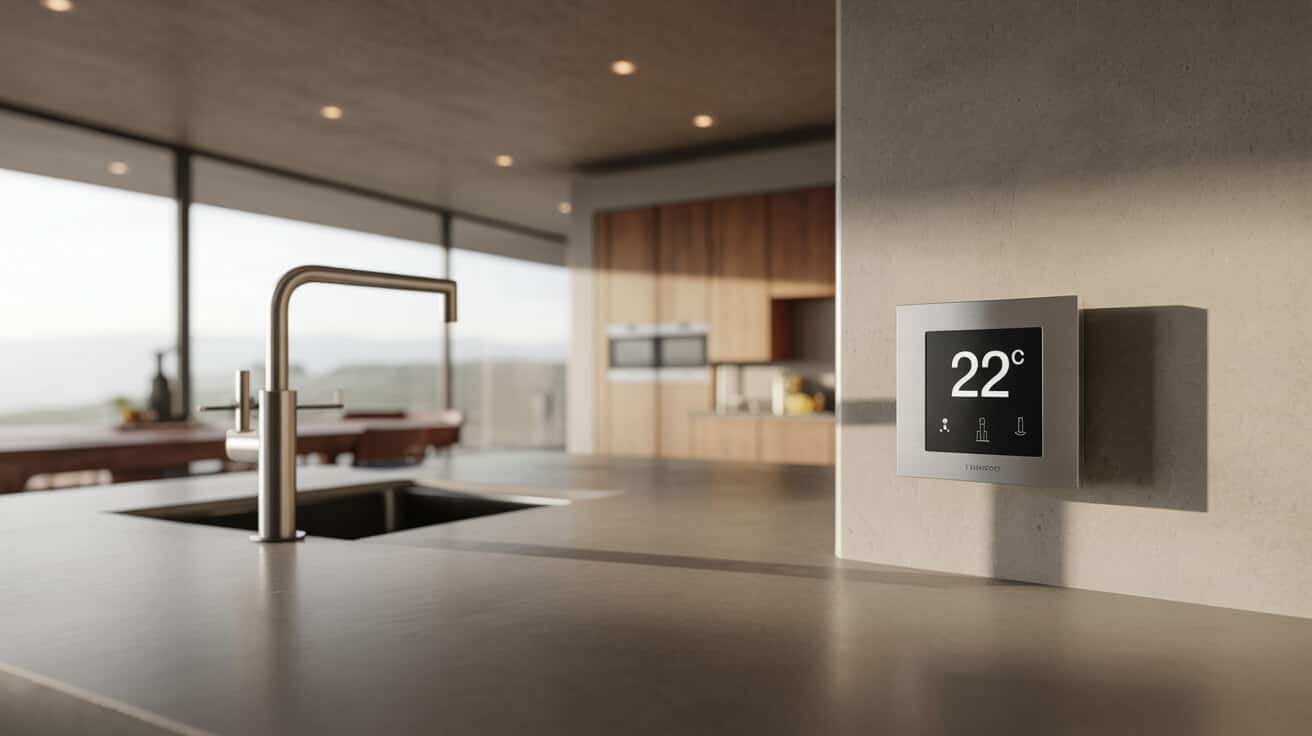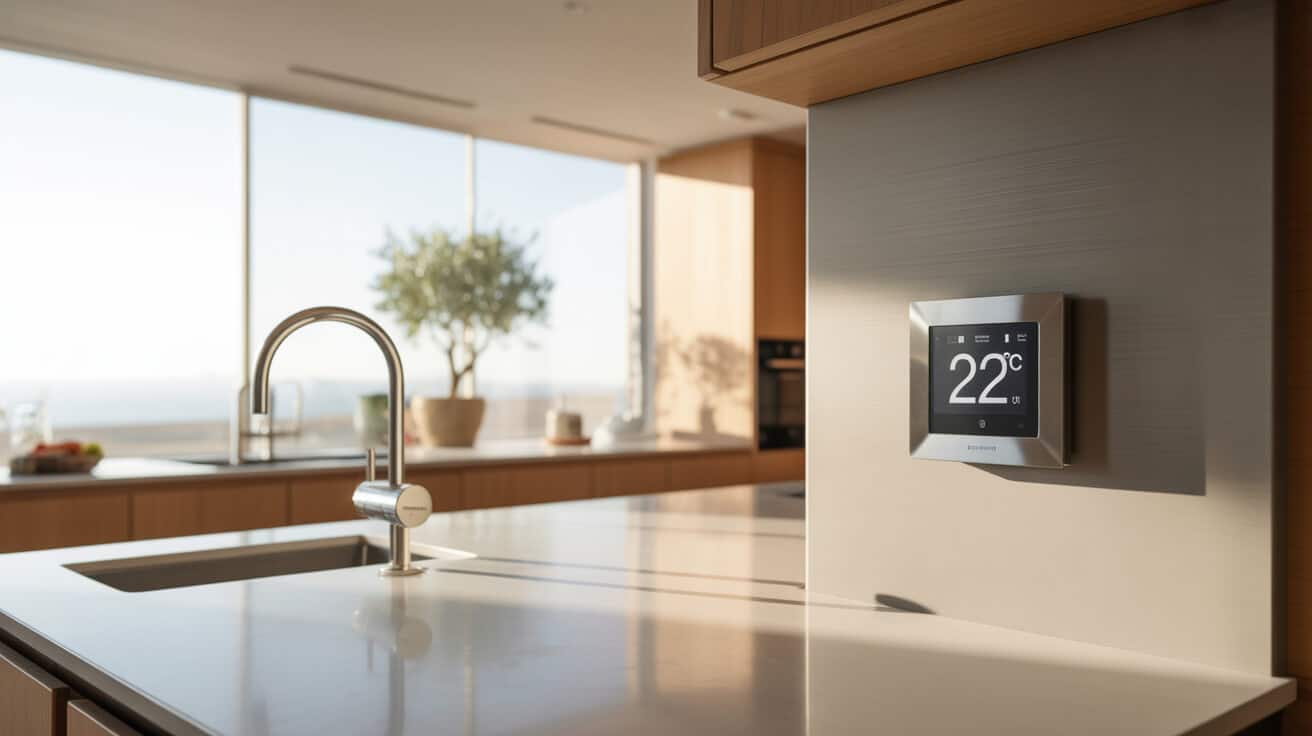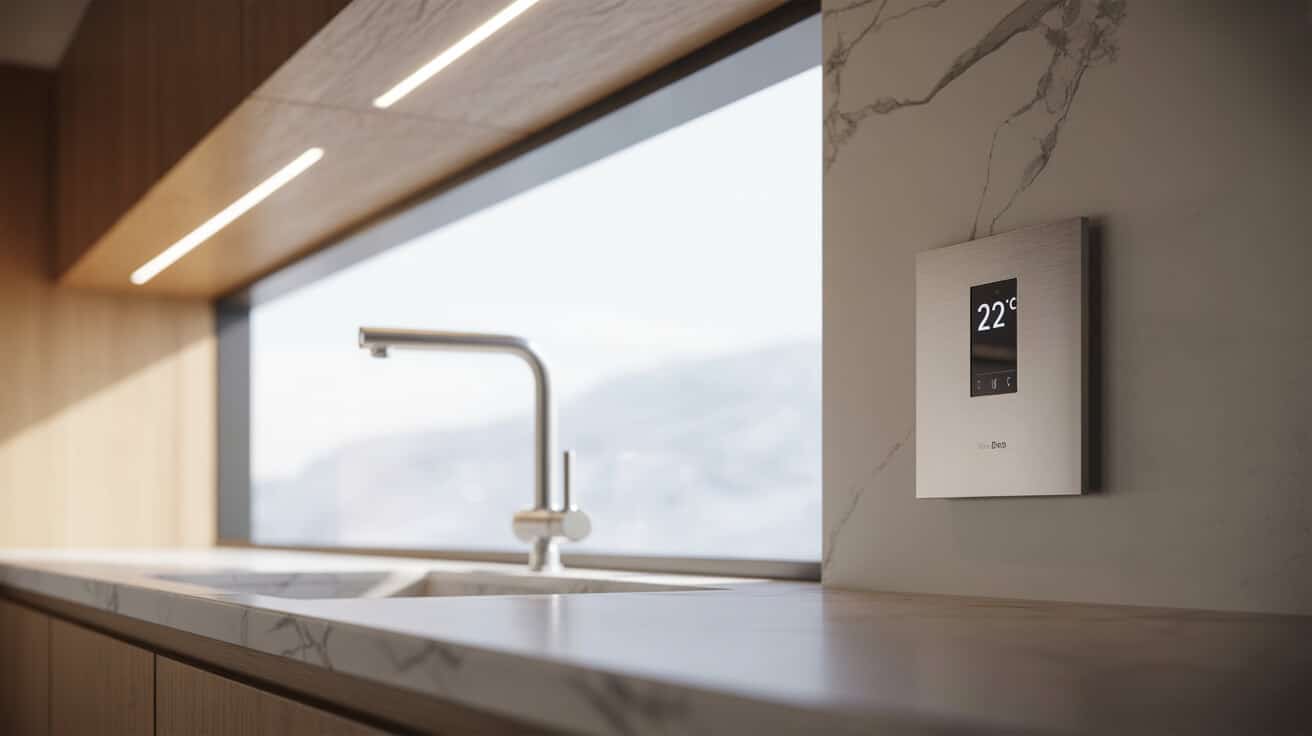By continuously modulating boiler flow temperature or burn cycle according to internal load, rather than simple external triggers or static scheduling, load compensation offers a transformative impact for homeowners seeking reliable efficiency, property managers prioritising longevity and compliance, and clients seeking reduced running costs and improved environmental performance. Within the plumbing and heating industry, companies such as Plumbers 4U incorporate load compensation as a core element of service, enabling your heating system to meet dynamic environmental challenges while maintaining comfort, efficiency, and lawful operation.
Load compensation describes a proactive heating control strategy in which system output is finely regulated according to ongoing measurements from in-situ sensors tracking internal space temperatures. Unlike legacy approaches that toggle on/off with significant lag or respond primarily to outdoor conditions, these controls respond directly to the gradient between actual and target temperatures in your rooms or building. The result is smoother, more energy-efficient operation, with fewer abrupt heating cycles, reduced wear on equipment, and a measurable contribution to regulatory and sustainability targets.
Modern regulatory landscapes, such as the UK’s Boiler Plus legislation and the evolution of Building Regulations Part L, have made the deployment of load compensation a de-facto standard for new installations and retrofits. These policies reflect a broader global focus on carbon management, cost control, and continuous improvement in building services. System modularity, retrofit accessibility, and protocol compatibility mean that load compensation helps align your company or household with best practices regardless of property age or design.
Etymology or Name Origin
The phrase “load compensation” originated in the lexicon of control engineering, with “load” referring to the thermal demand within a controlled space and “compensation” denoting the system’s adjustment of output to maintain stability. In the context of heating, load compensation describes the ability of a boiler control to modulate its action in precise response to changing internal heat demand. The term migrated from academic literature into industry standards and regulations during the late 20th century, paralleling the rise of more advanced programmable and modulating systems in both commercial and residential settings. As digital building management replaced purely mechanical systems, the terminology became foundational in service, compliance, and technical conversations among engineers and service firms, including Plumbers 4U.
Overview / Context
The demand for more intelligent heating management has markedly altered the control landscape in your property and across the sector. Traditional on/off thermostats, once sufficient for simple room-by-room or whole-building heating, have given way to layer-upon-layer of feedback algorithms, sensor-enabled modules, and standards-compliant digital controllers. Modern heating controls not only influence room comfort but also intersect with your legal responsibilities, energy bills, and environmental impact assessments.
Among the available control modes:
- On/off control: Simple toggling based on temperature setpoint, prone to overshoot and cycling.
- Proportional modulation: Smooth, incremental adjustment to heating based on distance from setpoint.
- Weather compensation: Adjusts system output based on outdoor temperature readings.
- Load compensation: Uses direct measurements from within your heated zone, providing continuous feedback for system output in direct proportion to need.
Load compensation is particularly valued in contexts where rapid changes to internal environment—caused by variable occupancy, insulation upgrades, or user behaviour—make fixed controls insufficient. In diverse settings from retail to multi-unit residential, property managers now often consider load compensation essential to minimising comfort complaints, achieving EPC goals, and passing compliance inspections.
Use Cases by User Persona
| Persona | Benefits & Use Cases |
|---|---|
| Homeowner/Tenant | Smoother room temperatures, energy savings, simple upgrades |
| Landlord/Asset Manager | Compliance with letting law, EPC support, tenant satisfaction |
| Facilities Director | Multi-zone/multi-property efficiency, BMS integration |
| Installer/Engineer | Reduced call-backs, easier commissioning, compliance evidence |
History
Origins
Manual heating control originated with straightforward thermostatic devices in the 19th and early 20th centuries, providing a rudimentary means of regulating boiler activity. These on/off switches offered little granularity, often resulting in under- or overheating, energy wastage, and occupant discomfort. The emergence of electromechanical sensors marginally improved precision, but left significant gaps in overall efficiency and user autonomy.
Industrial Emergence
The post-war era saw the introduction of proportional, integral, and derivative (PID) logic in process industries, optimising energy use in factories and infrastructure through continuous monitoring and control. By the 1970s and 1980s, property and facility managers increasingly sought similar intelligence for domestic and commercial buildings, driving the integration of proportional and load-compensation features in heating technology.
Contemporary Evolution
Advances in digital technology and low-cost sensor hardware during the 1990s and 2000s rapidly expanded the capacity for feedback-driven heating in new builds and retrofits. As energy costs rose and environmental concerns became central, national regulations began requiring some form of adaptive modulation—culminating in the UK’s Boiler Plus standard (2018), which mandates load compensation, weather compensation, or comparable controls in most new heating installations. Today, digital load compensation is not simply a feature, but a regulatory expectation for new and upgrading properties.

Concept / Description
Load compensation functions via a real-time feedback loop, in which one or more indoor sensors measure the difference between your property’s actual temperature and the pre-set target. The control’s internal processor computes a proportional output instruction, reducing or increasing the boiler’s flow temperature, and thus heat supply, according to this differential. This approach rapidly fine-tunes the delivered warmth, resulting in both greater comfort and improved efficiency.
Technical Structure
- Sensors are installed within one or more heated spaces, providing continual measurements.
- Control interface or processor interprets sensor signals and user input.
- Algorithmic output modulates the boiler’s water temperature or firing rate.
- User interface may enable temperature setpoints, schedules, or service alerts.
In contrast to weather compensation, which modifies boiler output in response to changes in outdoor temperature, load compensation is responsive to the actual status of the interior space. This internal focus assures a direct, reliable link between your actual need and the system’s behaviour. For multi-zone or hybrid setups (e.g. underfloor heating, radiators, convectors), this logic can be run in parallel, with each zone’s sensor looping back to a central control panel or distributed controller.
Schematic Illustration
A typical load compensation system creates a continuous thread:
- Temperature sensor → Control processor → Output calculation → Modulated flow temperature → Boiler → Heated emitters → Room temperature shift → Sensor feedback (and repeat)
User Experience
Your control system’s ability to anticipate and gradually provide only as much heat as required reduces temperature swings and minimises unnecessary cycling of the boiler, translating to lower fuel bills, quieter system operation, and enhanced longevity.
Functionality / Purpose / Applications
Residential Settings
- Delivers improved comfort by adjusting heat flow specifically to room and occupancy patterns.
- Reduces running costs by continuously fine-tuning output, rather than toggling at extremes.
- Supports quick upgrades of existing heating systems if compatible control and boiler hardware is present.
Commercial and Institutional Use
- Enables precise management of multi-zone systems, serving the variable schedules of retail, office, educational, or healthcare premises.
- Centralises efficiency, with one or more controllers balancing loads for entire buildings or campuses.
- Facilities directors rely on load compensation both to meet regulatory minimums and to cut operational expenses.
Retrofitting and Upgrade
- Suits older installations where new control logic can be added to compliant boilers.
- Increases system responsiveness and comfort without the expense and disruption of full system replacement.
- May improve grant eligibility or contribute to compliance with stricter rental or business property standards.
Value to Management and Maintenance
- Property managers experience fewer tenant or owner complaints and support challenges when heating is steady and responsive.
- Documented efficiency improvements bolster asset value and regulatory standing.
- Companies such as Plumbers 4U utilise these controls as part of their overall compliance and customer satisfaction programmes, emphasising regular documentation and service intervals.
Classifications / Types / Variants
Control Logics
- Proportional (P): Direct adjustment based on current error magnitude.
- Proportional-Integral (PI): Includes consideration of past error accumulation, reducing lingering deviations.
- Proportional-Integral-Derivative (PID): Adds anticipatory correction to changes in the error signal, enhancing stability in complex systems.
Hardware Integration Types
- Standalone Digital Thermostats: Retrofit replacements for legacy wall thermostats offering a single zone feedback loop.
- Integrated System Controllers: Multi-zone, whole-house, or large property BMS platforms embedding load compensation across several spaces.
- Smart Thermostats: Device-agnostic units interfacing with Wi-Fi or home automation protocols.
Protocol and Communication
| Protocol | Interoperability | Typical Brands |
|---|---|---|
| OpenTherm | Multi-vendor, open | Vaillant, Baxi, Ideal |
| EMS/eBus | Manufacturer proprietary | Worcester Bosch, Viessmann |
| Analogue | Minimal, legacy | Older systems |
Emitter and Zone Flexibility
- Radiator, underfloor, and hybrid heating with unique feedback loop per emitter or aggregate logic for single circuit multi-zone.
Systems / Tools / Methodologies
Key System Components
- Environmental Sensors: Accurately positioned within key zones; low drift and rapid response crucial.
- Control Processors: Embedded within wall panels, dedicated rooms, or BMS in commercial settings.
- User Interfaces: Ranging from basic dials to touchscreens with advanced schedule/zone mapping.
Software & Logic
- Load compensation algorithms tuned during commissioning to match property behaviour and heat delivery equipment.
- User-driven inputs for comfort scheduling and override modes.
Installation, Commissioning & Maintenance
- Assessment of system compatibility and emitter typology.
- Careful sensor placement for representative temperature measurement.
- Programming of control system for dwelling/zone requirements.
- Verification of system feedback and correct modulation output through test cycles.
- Service documentation and owner/occupant handover, including regulatory paperwork.
Diagnostic and Troubleshooting
- Fault logging with explicit feedback for quick identification of common issues (wrong sensor placement, control algorithm error, firmware mismatch).
- Annual review points typically included in property and landlord maintenance plans.

Stakeholders / Entities Involved
Manufacturers
Major developers include Honeywell, Drayton, Vaillant, Worcester Bosch, Ideal, Tado, Salus, and their respective protocol alliances (OpenTherm, EMS, eBus). Certification bodies coordinate interoperability and electronics safety.
Professional Service Providers
- Plumbers 4U and similar firms act as installers, service managers, and compliance auditors.
- Engineers and specifiers translate property needs to optimal control logic selection and placement.
- Facilities directors oversee system performance in multi-unit or institutional settings.
Regulatory and Advocacy Organisations
- Gas Safe Register and the Chartered Institute of Plumbing and Heating Engineering (CIPHE) manage installer accreditation.
- Local authority officers oversee statutory compliance and safety documentation.
Landlord and Tenant Representatives
Industry and legal groups offer guidance and support to protect all stakeholders, ensuring efficiency measures are equitable, enforceable, and user-centric.
Legal / Regulatory / Ethical Considerations
Boiler Plus and Building Regulations
Recent UK law, notably Boiler Plus, requires that all new combi boilers be installed with an advanced control, in which load compensation is a defined compliant option. Part L of the Building Regulations articulates the technical baseline for efficiency in both retrofits and new builds.
Documentation and Commissioning
Your support for compliance is buttressed by rigorous documentation, including benchmark logbooks, commissioning records, and system service updates. For landlords, documentation is a legal requirement to maintain rental rights.
Tenant and Landlord Responsibilities
Landlords have an obligation to provide modern, reliable heating meeting minimum statutory standards. Tenants, in turn, should have access to control interfaces, usage documentation, and transparent reporting.
Privacy, Data and System Security
With advanced programmable and remotely managed controls, system security and user privacy require continuous attention. Installers are expected to ensure device settings comply with UK data and privacy law.
Performance Metrics / Data / Measurements
Efficiency and Savings
Load compensation delivers quantifiable reductions in fuel consumption, with academic and industry studies suggesting savings of 5%–15% annually when compared with non-modulating or on/off regime controls. Upgrades often translate directly into improved EPC and comfort scores.
User Comfort and Stability
Surveys and performance monitoring report a reduction in temperature variation and system noise, fewer complaints related to room or zone overheating or underheating, and high user ratings on comfort and independence.
Commissioning Success and Fault Rates
Properly installed systems, following manufacturer and industry guidance, achieve high first-pass commissioning rates. Service records show lower recurrence rates of user-originated faults and improved maintenance intervals.
Comparative Table: System Outcomes
| Outcome | Non-Modulating | Load Compensation |
|---|---|---|
| Energy Consumption | High | Lower |
| Comfort Stability | Variable | Stable |
| regulatory compliance | Rare | Frequent |
| Occupant Control | Manual only | Adaptive |
| Asset Value | Neutral | Positive |
Challenges / Barriers / Limitations
Technical Complexity
- Not all legacy boilers support modulation or digital feedback. Installers may encounter limitations in sensor wiring, zone mapping, or hardware interface.
- Firmware bugs and control logic errors may cause malfunction or revert the boiler to simple on/off operation.
Economic Considerations
- Initial installation cost for sensors, wiring, and controls may exceed basic thermostat retrofit, though typically recouped through running cost savings.
- Variable device availability and skilled labour impact rollout rates, especially outside metropolitan centres.
Social and Cultural Hurdles
- Occupant wariness—change aversion, lack of interest in system complexity or perceived loss of autonomy—may hinder uptake.
- The need for training in use and programming is essential, as automated features can be misunderstood or overridden.
Regulatory and Philosophical Issues
- Balancing universal design with specialised, property-specific optimization is a developing discussion in both professional and legal circles.
- The tension between prescriptive code frameworks and practical field realities remains.
Impact / Influence / Legacy
Environmental and Regulatory Impact
Load compensation is acknowledged by regulatory agencies for its role in driving down carbon emissions and energy use across the housing and rental markets. It aids your organisation or property in meeting both present and emerging compliance thresholds.
Property Market and Value
Properties fitted with compliant, modulating control systems often realise improved market valuations, rental retention, and lower operational risk. For your company or your tenants, documentation and a record of upgrades can form part of the compliance and insurance framework.
Comfort, Reputation, and Professional Practice
Regular use of load compensation aligns with best practice, reducing day-to-day discomfort and minimising complaints. Customers increasingly rate both product and service providers by their ability to reduce costs and regulatory risk. Plumbers 4U and allied services promote this integration as core to their property management and facilities oversight offers.
Future directions, cultural relevance, and design discourse
Emergent technologies promise even more granular and predictive feedback patterns, incorporating pattern recognition, learning algorithms, and deeper integration with renewable systems or district heating networks. Proposals for next-generation building codes indicate that multi-factor, adaptive control will soon become mandatory, extending beyond heating to encompass other building services.
Culturally, the drive for comfort, sustainability, and cost-efficiency converges in the ongoing conversation around what comprises an intelligent, ethical, and universally beneficial property infrastructure. Continued debate over system equity and user access remains active in policy councils and professional bodies. For service providers, forward-thinking investment in training and compliance alongside continued collaboration with device manufacturers positions your company advantageously in a rapidly evolving energy and regulatory environment.

